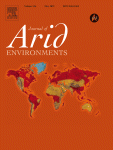Ver ítem
- xmlui.general.dspace_homeCentros Regionales y EEAsCentro Regional Patagonia SurEEA Santa CruzArtículos científicosxmlui.ArtifactBrowser.ItemViewer.trail
- Inicio
- Centros Regionales y EEAs
- Centro Regional Patagonia Sur
- EEA Santa Cruz
- Artículos científicos
- Ver ítem
The effects of land management (grazing intensity) vs. the effects of topography, soil properties, vegetation type, and climate on soil carbon concentration in Southern Patagonia
Resumen
Grazing is an economically important activity in Southern Patagonia’s steppe and woodland ecosystems.
In the past, emphasis has been on maximizing the provisioning capacity of these ecosystems with little
concern for the longer term conservation of the ecosystem services related to climate regulation, like
carbon sequestration. This is changing rapidly as livestock producers in the region work to develop a
certification scheme for sustainable land
[ver mas...]
Grazing is an economically important activity in Southern Patagonia’s steppe and woodland ecosystems.
In the past, emphasis has been on maximizing the provisioning capacity of these ecosystems with little
concern for the longer term conservation of the ecosystem services related to climate regulation, like
carbon sequestration. This is changing rapidly as livestock producers in the region work to develop a
certification scheme for sustainable land management for Patagonians rangelands. This study is a scientific
contribution towards this broader social objective in which we test whether soil C concentration
in topsoil (10 cm depth) can be used as an indicator of rangeland condition. Data on climate, soil
chemistry, topography, ecosystem type and stocking rates were obtained from the PEBANPA network of
permanent plots database for 145 sites across Southern Patagonia. These variables were used as independent
variables in a partial least squares regression in which top soil C was the dependent variable.
The effects of land use (stocking rate) on top soil C were barely detectable at the regional scale in
Patagonia. Top soil C was however strongly associated with other independent variables, notably soil
chemistry and climate variables and also vegetation type. Thus, changes in land use management may
not have a significant impact on soil carbon sequestration in these types of ecosystems. This may be
because many factors interact to determine top soil C such that the footprint of overgrazing on top soil C
is drowned out at the regional scale by other variables. This highlights the need for further work to
develop indicators for sustainable land management in the region.
[Cerrar]

Autor
Peri, Pablo Luis;
Ladd, Brenton;
Lasagno, Romina Gisele;
Martínez Pastur, Guillermo José;
Fuente
Journal of arid environments 134 : 73-78. (November 2016)
Fecha
2016-11
Editorial
Elsevier
ISSN
0140-1963
Formato
pdf
Tipo de documento
artículo
Palabras Claves
Derechos de acceso
Restringido
 Excepto donde se diga explicitamente, este item se publica bajo la siguiente descripción: Creative Commons Attribution-NonCommercial-ShareAlike 2.5 Unported (CC BY-NC-SA 2.5)
Excepto donde se diga explicitamente, este item se publica bajo la siguiente descripción: Creative Commons Attribution-NonCommercial-ShareAlike 2.5 Unported (CC BY-NC-SA 2.5)

